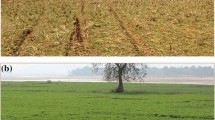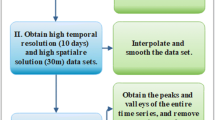Abstract
The present study was conducted to analyze cropping intensity of four blocks (Mogra-Chinsurah, Polba-Dadpur, Singur and Haripal) of the Gangetic alluvial zone of India using multi-dated Sentinel-2 data in 2018–19 cropping year. It was observed that during peak growing stage all crops ascribed higher Normalized Difference Vegetation Index NDVI values (0.4 to 0.73) and NDVI became as low as 0.06 when the fields were vacant. Sentinel-2 data acquired in the peak crop growing period during each cropping season were carefully selected, and NDVI was computed over the whole study area. Rule-based classification was applied for cropping sequence and cropping intensity classification based on the occurrence and non-occurrence of crops using NDVI threshold (0.4). Sentinel-2 images acquired on 22/10/2018, 6/12/2018, 30/1/2019 and 30/4/2019 were used for masking of trees and non-agricultural area. October 22, January 30 and April 30 imageries demonstrated peak crop growing period during kharif, rabi and pre-kharif seasons whereas December 6 image represented occurrence of no or little crop in the study area. Crop acreage was the highest in Polba-Dadpur block during all the three seasons. The crop–fallow—crop sequence occupied the highest areas (43%) followed by crop–crop–crop sequence (39%). 50% and 39% of the total cultivated land was under 200% and 300% cropping intensities. Overall, accuracies of cropping system and cropping intensity classification were 88.54% and 87.85%, respectively. Sentinel-2 data can be successfully used for cropping system analysis which helps in crop planning and management.












Similar content being viewed by others
References
Anderegg, J., Yu, K., Aasen, H., Walter, A., Liebisch, F., & Hund, A. (2020). Spectral vegetation indices to track senescence dynamics in diverse wheat germplasm. Frontiers in Plant Science, 10, 1749. https://doi.org/10.3389/fpls.2019.01749
Berhane, T. M., Lane, C. R., Wu, Q., Autrey, B. C., Anenkhonov, O. A., Chepinoga, V. V., & Liu, H. (2018). Decision-tree, rule-based, and random forest classification of high-resolution multispectral imagery for wetland mapping and inventory. Remote Sensing, 10(4), 580. https://doi.org/10.3390/rs10040580
Butt, A., Shabbir, R., Ahmad, S. S., & Aziz, N. (2015). Land use change mapping and analysis using remote sensing and GIS: A case study of simly watershed, Islamabad, Pakistan. The Egyptian Journal of Remote Sensing and Space Science, 18(2), 251–259. https://doi.org/10.1016/j.ejrs.2015.07.003
Cian, F., Marconcini, M., & Ceccato, P. (2018). Normalized difference flood index for rapid flood mapping: Taking advantage of EO big data. Remote Sensing of Environment, 209, 712–730.
Daniels, A. E. (2006). Incorporating domain knowledge and spatial relationships into land cover classifications: A rule-based approach. International Journal of Remote Sensing, 27(14), 2949–2975. https://doi.org/10.1080/01431160600567753
Deshmukh, M. S., & Tanaji, S. V. (2017). Cropping intensity index and irrigation intensity in India. North Asian International Research Journal of Social Science and Humanities, 3(2), 3–10.
FAO (Food and Agriculture Organization of the United Nations). (2009). Global agriculture towards 2050: How to feed the world. Rome
Feng, Q., Yang, J., Zhu, D., Liu, J., Guo, H., Bayartungalag, B., & Li, B. (2019). Integrating multitemporal sentinel-1/2 data for coastal land cover classification using a multibranch convolutional neural network: A case of the yellow river delta. Remote Sensing, 11(9), 1006. https://doi.org/10.3390/rs11091006
Friedl, M. A., McIver, D. K., Hodges, J. C., Zhang, X. Y., Muchoney, D., Strahler, A. H., & Baccini, A. (2002). Global land cover mapping from MODIS: Algorithms and early results. Remote Sensing of Environment, 83(1–2), 287–302.
Ghosh, S., & Ghosh, P. (2017). Spatial disparity in agricultural development and productivityin hooghly district. 2011 IOSR Journal Of Humanities And Social Science, 22(11), 95–99.
Ghosh, P., Mandal, D., Bhattacharya, A., Nanda, M. K., & Bera, S. (2018). Assessing crop monitoring potential of sentinel-2 in a spatio-temporal scale. International Archives of the Photogrammetry, Remote Sensing and Spatial Information Sciences. https://doi.org/10.5194/isprs-archives-XLII-5-227-2018
Ghosh, A., Nanda, M. K., Sarkar, D., Sarkar, S., Brahmachari, K., & Ray, K. (2019). Application of multi-dated sentinel-2 imageries to assess the cropping system in Gosaba Island of Indian Sundarbans. Journal of Indian Society of Coastal Agricultural Research, 37(2), 32–44.
Havyas, V. B., Choodarathnakara, A. L., Thribhuvan, R., & Chethan, K. S. (2015). Decision tree approach for classification of satellite imagery. International Journal of Soft Computing and Engeneering, 5(2), 2231–2307.
Kuenzer, C., & Knauer, K. (2013). Remote sensing of rice crop areas. International Journal of Remote Sensing, 34(6), 2101–2139.
Kundu, R., Dutta, D., Chakrabarty, A., & Nanda, M. K. (2018). Spatial growth pattern of potato in West Bengal using multi-temporal MODIS NDVI Data. International Journal of Computer Sciences and Engineering, 6, 52–59. https://doi.org/10.26438/ijcse/v6i6.5259
Li, J., & Chen, W. (2005). A rule-based method for mapping Canada’s wetlands using optical, radar and DEM data. International Journal of Remote Sensing, 26(22), 5051–5069. https://doi.org/10.1080/01431160500166516
Liu, X., Zhai, H., Shen, Y., Lou, B., Jiang, C., Li, T., & Shen, G. (2020). Large-scale crop mapping from multisource remote sensing images in google earth engine. IEEE Journal of Selected Topics in Applied Earth Observations and Remote Sensing, 13, 414–427.
Maity, D. K., & Mandal, S. (2019). Identification of groundwater potential zones of the Kumari river basin, India: An RS & GIS based semi-quantitative approach. Environment, Development and Sustainability, 21(2), 1013–1034. https://doi.org/10.1007/s10668-017-0072-0
Mandal, D., Kumar, V., Rao, Y. S., Bhattacharya, A., Bera, S., & Nanda, M. K. (2018). Combined analysis of radarsat-2 sar and sentinel-2 optical data for improved monitoring of tuber initiation stage of potato. International Archives of the Photogrammetry, Remote Sensing & Spatial Information Sciences. https://doi.org/10.5194/isprs-archives-XLII-5-275-2018
Marshall, M., & Thenkabail, P. (2015). Advantage of hyperspectral EO-1 Hyperion over multispectral IKONOS, GeoEye-1, WorldView-2, Landsat ETM+, and MODIS vegetation indices in crop biomass estimation. ISPRS Journal of Photogrammetry and Remote Sensing, 108, 205–218.
Meer, M. S., & Mishra, A. K. (2020). Remote sensing application for exploring changes in land-use and land-cover over a district in Northern India. Journal of the Indian Society of Remote Sensing. https://doi.org/10.1007/s12524-019-01095-2
Mercier, A., Betbeder, J., Rumiano, F., Baudry, J., Gond, V., Blanc, L., & Hubert-Moy, L. (2019). Evaluation of sentinel-1 and 2 time series for land cover classification of forest–agriculture mosaics in temperate and tropical landscapes. Remote Sensing, 11(8), 979. https://doi.org/10.3390/rs11080979
Miller, R. B., & Small, C. (2003). Cities from space: Potential applications of remote sensing in urban environmental research and policy. Environmental Science and Policy, 6(2), 129–137.
Mishra, D., & Singh, B. N. (2019). Derivation of magnitude of crop diversity through NDVI composite index using sentinel-2 satellite imagery. Journal of the Indian Society of Remote Sensing, 47(5), 893–906. https://doi.org/10.1007/s12524-019-00951-5
Mondejar, J. P., & Tongco, A. F. (2019). Near infrared band of landsat 8 as water index: A case study around Cordova and Lapu-Lapu City, Cebu Philippines. Sustainable Environment Research, 29(1), 16. https://doi.org/10.1186/s42834-019-0016-5
Nguy-Robertson, A., Gitelson, A., Peng, Y., Walter-Shea, E., Leavitt, B., & Arkebauer, T. (2013). Continuous monitoring of crop reflectance, vegetation fraction, and identification of developmental stages using a four band radiometer. Agronomy Journal, 105(6), 1769–1779. https://doi.org/10.2134/agronj2013.0242
Ottosen, T. B., Lommen, S. T., & Skjøth, C. A. (2019). Remote sensing of cropping practice in Northern Italy using time-series from Sentinel-2. Computers and Electronics in Agriculture, 157, 232–238.
Pasqualotto, N., Delegido, J., Van Wittenberghe, S., Rinaldi, M., & Moreno, J. (2019). Multi-crop green LAI estimation with a new simple Sentinel-2 LAI Index (SeLI). Sensors, 19(4), 904. https://doi.org/10.3390/s19040904
Ramoelo, A., Cho, M., Mathieu, R., & Skidmore, A. K. (2015). Potential of Sentinel-2 spectral configuration to assess rangeland quality. Journal of Applied Remote Sensing, 9(1), 094096. https://doi.org/10.1117/1.JRS.9.094096
Rouse, J. W., Haas, R. H., Schell, J. A.& Deering, D. W. (1974). Monitoring Vegetation Systems in the Great plains with ERTS. In Proceedings of the 3rd ERTS-1 Symposium NASA SP-351, Washington, DC, USA, 10–14 December 1973; Volume 1, pp. 309–317
Sahu, A. S. (2014). A study on Moyna Basin waterlogged areas India using remote sensing and GIS methods and their contemporary economic significance. Geography Journal. https://doi.org/10.1155/2014/401324
Sarkar, A., Banasree, K., Madhurima, D., & Banik, P. (2012). Appraisal and mapping of soil resources of selected blocks (Hooghly district) in the Bengal basin region of India using GIS and Remote Sensing. International Journal of Scientific & Engineering Research, 3, 1–5.
Satyawan, M. Y., & Hooda, R. S. (2014). Cropping system analysis using geospatial approach: A case study of Sirsa District in Haryana, India. International Journal of Science and Research., 3(9), 2161–2167.
Sharma, R., Ghosh, A., & Joshi, P. K. (2013). Decision tree approach for classification of remotely sensed satellite data using open source support. Journal of Earth System Science, 122(5), 1237–1247. https://doi.org/10.1007/s12040-013-0339-2
Singh, A., & Kumar, A. (2019). Identification of paddy stubble burnt activities using temporal class-based sensor-independent indices database: Modified possibilistic fuzzy classification approach. Journal of the Indian Society of Remote Sensing. https://doi.org/10.1007/s12524-019-01093-4
Sonobe, R., Yamaya, Y., Tani, H., Wang, X., Kobayashi, N., & Mochizuki, K. I. (2017). Assessing the suitability of data from sentinel-1A and 2A for crop classification. Giscience and Remote Sensing, 54(6), 918–938. https://doi.org/10.1080/15481603.2017.1351149
Veettil, B. K., Wang, S., Simões, J. C., & Pereira, S. F. R. (2018). Glacier monitoring in the eastern mountain ranges of Bolivia from 1975 to 2016 using Landsat and Sentinel-2 data. Environmental Earth Sciences, 77(12), 452. https://doi.org/10.1007/s12665-018-7640-y
Veloso, A., Mermoz, S., Bouvet, A., Le Toan, T., Planells, M., Dejoux, J. F., & Ceschia, E. (2017). Understanding the temporal behavior of crops using sentinel-1 and sentinel-2-like data for agricultural applications. Remote Sensing of Environment, 199, 415–426. https://doi.org/10.1016/j.rse.2017.07.015
Verma, A., Kumar, A., & Lal, K. (2019). Kharif crop characterization using combination of SAR and MSI optical sentinel satellite datasets. Journal of Earth System Science, 128(8), 230. https://doi.org/10.1007/s12040-019-1260-0
Viera, A. J., & Garrett, J. M. (2005). Understanding interobserver agreement: The kappa statistic. Family Medicine, 37(5), 360–363.
Wu, W., You, L. & Chen, K. (2015). Cropping intensity gaps: The potential for expanded global harvest areas.IFPRI(International Food Policy Research Institute) Discussion Paper 1459.
Yang, N., Liu, D., Feng, Q., Xiong, Q., Zhang, L., Ren, T., & Huang, J. (2019). Large-scale crop mapping based on machine learning and parallel computation with grids. Remote Sensing, 11(12), 1500.
Acknowledgements
The authors express sincere gratitude to Bidhan Chandra Krishi Viswavidyalaya for supporting the present research. The authors are thankful to the farmers of Hooghly district of West Bengal for their kind hearted co-operation.
Funding
This research did not receive any specific grant from funding agencies in the public, commercial, or not-for-profit sectors.
Author information
Authors and Affiliations
Corresponding author
Ethics declarations
Conflict of interest
All the authors that they have no conflict of interest.
Additional information
Publisher's Note
Springer Nature remains neutral with regard to jurisdictional claims in published maps and institutional affiliations.
Rights and permissions
About this article
Cite this article
Ghosh, A., Nanda, M.K. & Sarkar, D. Assessing the spatial variation of cropping intensity using multi-temporal Sentinel-2 data by rule-based classification. Environ Dev Sustain 24, 10829–10851 (2022). https://doi.org/10.1007/s10668-021-01885-0
Received:
Accepted:
Published:
Issue Date:
DOI: https://doi.org/10.1007/s10668-021-01885-0




